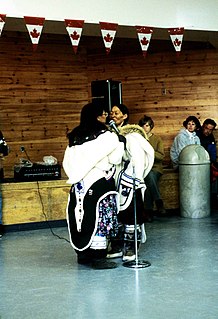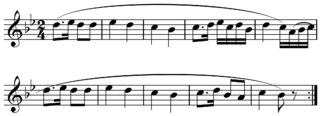A definition of music endeavors to give an accurate and concise explanation of music's basic attributes or essential nature and it involves a process of defining what is meant by the term music. Many authorities have suggested definitions, but defining music turns out to be more difficult than might first be imagined, and there is ongoing debate. A number of explanations start with the notion of music as organized sound, but they also highlight that this is perhaps too broad a definition and cite examples of organized sound that are not defined as music, such as human speech and sounds found in both natural and industrial environments. The problem of defining music is further complicated by the influence of culture in music cognition.
Semiotics is the systematic study of sign processes (semiosis) and meaning making. Semiosis is any activity, conduct, or process that involves signs, where a sign is defined as anything that communicates something, usually called a meaning, to the sign's interpreter. The meaning can be intentional such as a word uttered with a specific meaning, or unintentional, such as a symptom being a sign of a particular medical condition. Signs can also communicate feelings and may communicate internally or through any of the senses: visual, auditory, tactile, olfactory, or gustatory (taste). Contemporary semiotics is a branch of science that studies meaning-making and various types of knowledge.

Inuit throat singing, or katajjaq, is a distinct type of throat singing uniquely found among the Inuit. It is a form of musical performance, traditionally consisting of two women who sing duets in a close face-to-face formation with no instrumental accompaniment, in an entertaining contest to see who can outlast the other; however, one of the genre's most famous practitioners, Tanya Tagaq, performs as a solo artist. Several groups, including Tudjaat, The Jerry Cans, Quantum Tangle and Silla + Rise, also now blend traditional throat singing with mainstream musical genres such as pop, folk, rock and dance music.

Musical analysis is the study of musical structure in either compositions or performances. According to music theorist Ian Bent, music analysis "is the means of answering directly the question 'How does it work?'". The method employed to answer this question, and indeed exactly what is meant by the question, differs from analyst to analyst, and according to the purpose of the analysis. According to Bent, "its emergence as an approach and method can be traced back to the 1750s. However it existed as a scholarly tool, albeit an auxiliary one, from the Middle Ages onwards."

The emancipation of the dissonance was a concept or goal put forth by composer Arnold Schoenberg and others, including his pupil Anton Webern. The phrase first appears in Schoenberg's 1926 essay "Opinion or Insight?". It may be described as a metanarrative to justify atonality. Jim Samson describes:
As the ear becomes acclimatized to a sonority within a particular context, the sonority will gradually become 'emancipated' from that context and seek a new one. The emancipation of the dominant-quality dissonances has followed this pattern, with the dominant seventh developing in status from a contrapuntal note in the sixteenth century to a quasi-consonant harmonic note in the early nineteenth. By the later nineteenth century the higher numbered dominant-quality dissonances had also achieved harmonic status, with resolution delayed or omitted completely. The greater autonomy of the dominant-quality dissonance contributed significantly to the weakening of traditional tonal function within a purely diatonic context.

In music, a motif(pronunciation) (help·info) IPA: (/moʊˈtiːf/) is a short musical phrase, a salient recurring figure, musical fragment or succession of notes that has some special importance in or is characteristic of a composition: "The motive is the smallest structural unit possessing thematic identity".
Traditional Inuit music, the music of the Inuit, Yupik, and Iñupiat, has been based on drums used in dance music as far back as can be known, and a vocal style called katajjaq has become of interest in Canada and abroad.
In semiotics, a sign is anything that communicates a meaning that is not the sign itself to the interpreter of the sign. The meaning can be intentional, as when a word is uttered with a specific meaning, or unintentional, as when a symptom is taken as a sign of a particular medical condition. Signs can communicate through any of the senses, visual, auditory, tactile, olfactory, or taste.

In music theory, a phrase is a unit of musical meter that has a complete musical sense of its own, built from figures, motifs, and cells, and combining to form melodies, periods and larger sections.
A phrase is a substantial musical thought, which ends with a musical punctuation called a cadence. Phrases are created in music through an interaction of melody, harmony, and rhythm.

In music, a subject is the material, usually a recognizable melody, upon which part or all of a composition is based. In forms other than the fugue, this may be known as the theme.

Music can be analysed by considering a variety of its elements, or parts, individually or together. A commonly used list of the main elements includes pitch, timbre, texture, volume, duration, and form. The elements of music may be compared to the elements of art or design.

Jean-Jacques Nattiez is a musical semiologist or semiotician and professor of musicology at the Université de Montréal. He studied semiology with Georges Mounin and Jean Molino and music semiology (doctoral) with Nicolas Ruwet.

A musicalfigure or figuration is the shortest phrase in music; a short succession of notes, often recurring. It may have melodic pitch, harmonic progression, and rhythmic meter. The 1964 Grove's Dictionary defines the figure as "the exact counterpart of the German 'motiv' and the French 'motif'": it produces a "single complete and distinct impression". To the self-taught Roger Scruton, however, a figure is distinguished from a motif in that a figure is background while a motif is foreground:
A figure resembles a moulding in architecture: it is 'open at both ends', so as to be endlessly repeatable. In hearing a phrase as a figure, rather than a motif, we are at the same time placing it in the background, even if it is ... strong and melodious
Esthesic and poietic are terms used in semiotics, the study of signs, to describe perceptive and productive levels, processes, and analyses of symbolic forms. The corresponding terms for the processes are esthesis and poiesis.

The 1957 Encyclopédie Larousse defines a cell in music as a "small rhythmic and melodic design that can be isolated, or can make up one part of a thematic context". The cell may be distinguished from the figure or motif: the 1958 Encyclopédie Fasquelle defines a cell as "the smallest indivisible unit", unlike the motif, which may be divisible into more than one cell. "A cell can be developed, independent of its context, as a melodic fragment, it can be used as a developmental motif. It can be the source for the whole structure of the work; in that case it is called a generative cell."
Satz is any single member of a musical piece, which in and of itself displays a complete sense, such as a sentence, phrase, or movement.
In Western music theory, the term sentence is analogous to the way the term is used in linguistics, in that it usually refers to a complete, somewhat self-contained statement. Usually a sentence refers to musical spans towards the lower end of the durational scale; i.e. melodic or thematic entities well below the level of 'movement' or 'section', but above the level of 'motif' or 'measure'. The term is usually encountered in discussions of thematic construction. In the last fifty years, an increasing number of theorists such as William Caplin have used the term to refer to a specific theme-type involving repetition and development.
Music semiology (semiotics) is the study of signs as they pertain to music on a variety of levels.
The term seriation [mise en série] was proposed for use in semiotics by Jean Molino and derived from classical philology. Seriation "invokes the idea that any investigator, in order to assign some plausible meaning to a given phenomenon, must interpret it within a series of comparable phenomena." One cannot interpret what philology calls a hapax; that is, an isolated phenomenon. Art historian Erwin Panofsky has explained the situation in very clear terms:
The following outline is provided as an overview of and topical guide to semiotics:








